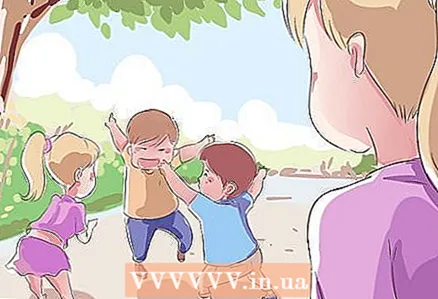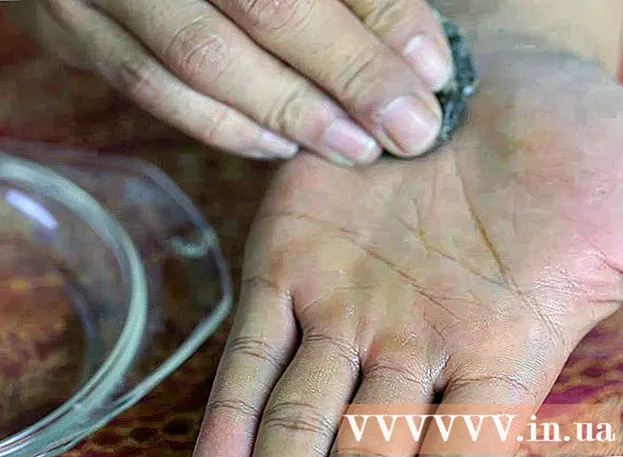Author:
Gregory Harris
Date Of Creation:
13 August 2021
Update Date:
22 June 2024

Content
- Steps
- Part 1 of 4: Teaching Your Child Social Skills
- Part 2 of 4: How to Have Play Meetings with Other Children
- Part 3 of 4: How to Encourage Play and Communication in Kindergarten
- Part 4 of 4: Helping Your Child Communicate in Public Places
- Tips
- Warnings
Some children easily make contact with others, and some find it difficult to find friends and engage in group activities. If your child is shy, hesitant, or afraid to communicate, then start instilling confidence and social skills in your child's home communication. Arrange meetings with other children in a comfortable environment so that your child does not feel stressed. When your baby gets used to play and one-on-one communication, teach him to interact with a group of children in kindergarten and other situations.
Steps
Part 1 of 4: Teaching Your Child Social Skills
- 1 Notice how your child interacts with other children. Watch how he behaves in different conditions: at home, on the playground, or visiting friends. Some children show a desire to play alone or with one friend, rather than in a large company. Sometimes the child prefers a calm environment without unnecessary noise.
- Place the baby in a new environment and watch his reaction. For example, if he is uncomfortable on the playground, then go with him to the park or visit friends.
- Change the company the child is in. So you will find out what is preferable to him: one-on-one communication, in small or large companies.
 2 Explain to your child when and why you are happy with their behavior. Doing so will teach him to understand good deeds and help him feel confident. Don't just praise your child. You should explain what he did right and why he did the right thing.
2 Explain to your child when and why you are happy with their behavior. Doing so will teach him to understand good deeds and help him feel confident. Don't just praise your child. You should explain what he did right and why he did the right thing. - For example, if your toddler shares a toy, say, “This is a very polite thing to do. Sharing with others is right, so that all children have good and fun! ".
- Always discuss the results of the child's behavior. For example, ask him to give a gift to his sister and say: “Look how happy she was! She loves your drawing so much! "
- Never criticize or shame your child for being shy. Better to praise his positive deeds.
 3 Teach your child to share toys. It is difficult for young children to understand why to share, but thanks to your attention to the question, the task can be simplified a little. At home, you can show the right behavior by example.
3 Teach your child to share toys. It is difficult for young children to understand why to share, but thanks to your attention to the question, the task can be simplified a little. At home, you can show the right behavior by example. - If you have other children, then encourage everyone to share with each other.Ask your toddler to give his little brother a toy or treat, then praise him for his generosity. Also ask the older children to share with the baby and thank them for their efforts.
- If you have one child, start sharing with your toddler yourself. Try sharing toys, food, and other items. Thank your baby when he shares with you.
- Make sure your behavior with other people is consistent with the behavior you teach your child. Ask your parents, other children, and family members to do the same.
 4 Read friendship picture books. Buy or borrow children's books from the library that address the issues of friendship, interaction, and non-greed. Read books to your child and remember to discuss the stories you read with them.
4 Read friendship picture books. Buy or borrow children's books from the library that address the issues of friendship, interaction, and non-greed. Read books to your child and remember to discuss the stories you read with them. - While reading, pause and ask how the baby would act in such a situation or what he would answer. Encourage your child to share their feelings.
- For example read Crocodile Gena and his friends Eduard Uspensky or Dunno Nikolai Nosov.
 5 Work through social situations in a playful way. Choose one situation, like going out for a birthday party or having to share a toy. Act out this situation with your child. If he does the right thing, praise the baby. If not, try to correct his behavior with the words "What if we are the first to ask Dima to share a toy with us?"
5 Work through social situations in a playful way. Choose one situation, like going out for a birthday party or having to share a toy. Act out this situation with your child. If he does the right thing, praise the baby. If not, try to correct his behavior with the words "What if we are the first to ask Dima to share a toy with us?" - You, your partner, brother or sister of the child can play the role of a friend with whom you need to communicate. Model the right behavior - teach your toddler to share and say thank you, please.
- You can also use puppets and soft toys for playing situations.
 6 Involve your toddler in family activities. Using the example of interaction with family members, he will learn to communicate with other children. Home help will teach him how to interact with others, share and care.
6 Involve your toddler in family activities. Using the example of interaction with family members, he will learn to communicate with other children. Home help will teach him how to interact with others, share and care. - For example, ask your child to help you set the table. Choose plates and cutlery together so your child can see that you value their opinion. Don't forget to thank your little one for their help.
- Play one-on-one with your baby or use siblings. Perhaps it will be easier and more comfortable for him to play with relatives. So he will learn to interact with others.
- Family activities outside the home, such as shopping for groceries or going to the beach, can help your child get used to the presence of other people.
 7 Invite friends over to simulate good social behavior. It is you who are the role model for the child. It will be easier for him to play with other children if the baby sees that you are communicating with friends and relatives. Be nice and friendly.
7 Invite friends over to simulate good social behavior. It is you who are the role model for the child. It will be easier for him to play with other children if the baby sees that you are communicating with friends and relatives. Be nice and friendly. - Do not leave your child aside when guests come. Be a good hostess. Use words like "please" and "thank you." This will help your little one see the correct behavior.
- Introduce your baby to your friends. Perhaps he will be a little shy, but this way he will begin to get used to other people.
Part 2 of 4: How to Have Play Meetings with Other Children
 1 Schedule short play meetings in your home. The child feels most comfortable in a familiar environment, so it is better to hold the first meetings at home. Avoid scheduling appointments for longer than an hour, as your baby can quickly get tired and irritable.
1 Schedule short play meetings in your home. The child feels most comfortable in a familiar environment, so it is better to hold the first meetings at home. Avoid scheduling appointments for longer than an hour, as your baby can quickly get tired and irritable. - It is also a great opportunity to teach your child the role of master of the house. Explain the importance of being kind and generous to guests.
 2 Involve your child in the planning process. Ask whom he would like to invite and what to do. Discuss possible situations like quarrels and talk about how to react or behave.
2 Involve your child in the planning process. Ask whom he would like to invite and what to do. Discuss possible situations like quarrels and talk about how to react or behave. - Remember, you can always rehearse meetings ahead of time.
 3 Choose one special friend instead of a group of children. At first, group meetings can only discourage the child. It is better to invite one friend whom the child already knows and loves. As the child gets used to such situations, you can expand the baby's circle of friends.
3 Choose one special friend instead of a group of children. At first, group meetings can only discourage the child. It is better to invite one friend whom the child already knows and loves. As the child gets used to such situations, you can expand the baby's circle of friends. - Ask your child whom he would like to invite.If he can't name anyone, think of your friends with children of about the same age or the kids in kindergarten. Ask the educators which of the children could come to you.
 4 Select toys and activities in advance. Choose activities that both children enjoy and prepare toys. Better to find several toys, ideally similar or identical. Quarrels over toys are the most common problem at play meetings for toddlers.
4 Select toys and activities in advance. Choose activities that both children enjoy and prepare toys. Better to find several toys, ideally similar or identical. Quarrels over toys are the most common problem at play meetings for toddlers. - Set aside your child's favorite toys for the meeting. You should not expect that he will agree to share his favorite things already in the first meetings with other children.
- Offer entertainment such as board games for the little ones or fictional games with toys and costumes.
- For such meetings, it is best to use plasticine, cubes, dolls and various figures.
 5 Play with your children. Do not leave babies alone, especially if one of them is uncomfortable. Your presence will help the child feel confident, and you will show the child how to communicate and interact correctly.
5 Play with your children. Do not leave babies alone, especially if one of them is uncomfortable. Your presence will help the child feel confident, and you will show the child how to communicate and interact correctly. - Always supervise children. If your child is playing around or being rude, take him aside and gently correct. For example, you might say, “Your friend hurts when you hit him. I need to apologize "
- Give the kids some fun if they get bored. For example, ask "Would you like to play ball in your backyard?" or "Who wants to draw on paper?"
- Engage the parent of the second child if he stays with you.
 6 Host in-game meetings at least once a week. When your toddler begins to respond positively to the presence of other children, start holding meetings as often as possible. Over time, the need for your participation will diminish and soon children will be able to play without you.
6 Host in-game meetings at least once a week. When your toddler begins to respond positively to the presence of other children, start holding meetings as often as possible. Over time, the need for your participation will diminish and soon children will be able to play without you.
Part 3 of 4: How to Encourage Play and Communication in Kindergarten
 1 Discuss the child's social needs with the provider. Call kindergarten and tell them that you are concerned about your child's social skills. Arrange to meet and discuss the situation one-on-one.
1 Discuss the child's social needs with the provider. Call kindergarten and tell them that you are concerned about your child's social skills. Arrange to meet and discuss the situation one-on-one. - Ask how the child interacts with other children. You can ask if the baby has a friend or if he often plays alone.
- Ask if your child has anger or shyness issues. Ask your provider to speak openly with you.
- Talk openly about what you can do to help your child develop communication outside the home.
 2 Let your child take favorite things to kindergarten. If you are allowed to take a toy with you, invite your baby to take his favorite thing. This will make him feel more confident and will be able to find friends with similar interests.
2 Let your child take favorite things to kindergarten. If you are allowed to take a toy with you, invite your baby to take his favorite thing. This will make him feel more confident and will be able to find friends with similar interests. - For example, if your toddler loves animals, invite him to choose a favorite stuffed animal. If he loves cars, then you can take a truck.
- For games like Show and Tell, discuss interests or activities with your child. You can bring a thing that matches the hobbies of the baby. For example, if your daughter loves to draw, then you can bring her drawings to the kindergarten.
 3 Play kindergarten at home to teach your child the right behavior. Offer your child to be a caregiver. Take on the role of a child, and in the role of other children, you can imagine dolls or stuffed animals. Ask the "educator" questions like "What if Olya doesn't want to share the book?" or "How do I invite someone to be my friend?"
3 Play kindergarten at home to teach your child the right behavior. Offer your child to be a caregiver. Take on the role of a child, and in the role of other children, you can imagine dolls or stuffed animals. Ask the "educator" questions like "What if Olya doesn't want to share the book?" or "How do I invite someone to be my friend?" - Role play can also help you learn about your child's hidden worries or concerns in kindergarten. For example, if your toddler wants to act out a bullying scenario, you might ask the provider to observe how others behave with your child.
 4 Teach your child to behave properly with bullies. Young children also fall victim to bullying. A shy child may refuse to confront more confident children in the group. Explain to your child what to do if others are being rude.
4 Teach your child to behave properly with bullies. Young children also fall victim to bullying. A shy child may refuse to confront more confident children in the group. Explain to your child what to do if others are being rude. - Explain that you need to be courageous and not be offended. Teach your child phrases like "Stop doing this" or "This hurts me."With young children, words are usually enough.
- Encourage your toddler to ignore this behavior. The child must understand that biting and hitting other children is unacceptable, even if they misbehave.
- If the problem persists, instruct your child to share the situation with an adult, such as a caregiver, parents, or other kindergarten staff.
Part 4 of 4: Helping Your Child Communicate in Public Places
 1 Teach your child to introduce themselves. The kid may experience difficulties due to the fact that everyone around him is strangers. Simple phrase “Hello, my name is Roma. Let's play together? " will become a useful skill.
1 Teach your child to introduce themselves. The kid may experience difficulties due to the fact that everyone around him is strangers. Simple phrase “Hello, my name is Roma. Let's play together? " will become a useful skill. - Practice this skill by role-playing with toys. Ask your child to introduce their toys to each other.
 2 Bring the child to places where other children will be. When your child gets used to play encounters at home, start going with him to other places for communication, such as parks, playgrounds or indoor play centers.
2 Bring the child to places where other children will be. When your child gets used to play encounters at home, start going with him to other places for communication, such as parks, playgrounds or indoor play centers.  3 Let your child make their own decisions. Excessive attempts to engage a child with interactions with other children can be stressful. Just take a place where you can clearly see your baby. He himself will approach the children when he is ready.
3 Let your child make their own decisions. Excessive attempts to engage a child with interactions with other children can be stressful. Just take a place where you can clearly see your baby. He himself will approach the children when he is ready. - If your child starts playing with others, monitor them in case of quarrels or dangerous activities.
 4 Let your child leave the game on their own. If the kid starts to quarrel, gets upset or tired and becomes irritable, then you can end the game and go home. Tell your child in advance, "Tell me when you get bored so we can go home."
4 Let your child leave the game on their own. If the kid starts to quarrel, gets upset or tired and becomes irritable, then you can end the game and go home. Tell your child in advance, "Tell me when you get bored so we can go home." - If the child is reluctant to play in crowded places, then such a "way out" will make the situation less scary in the eyes of the child. At first, he may not play for long, but over time, the child will gain self-confidence.
 5 Give credit to your child's efforts to participate in group activities. Give credit to his desire to find common ground with other children, even if the attempts are shy and short-lived at first. It takes time to build confidence and develop communication skills.
5 Give credit to your child's efforts to participate in group activities. Give credit to his desire to find common ground with other children, even if the attempts are shy and short-lived at first. It takes time to build confidence and develop communication skills. - For example, you might say, “I noticed that you invited the boy to play with you. You seem to have had fun. "
 6 Chat with other parents. When you are in public with your child, you need to be a role model and connect with other parents. It is important for a kid to see that you can always find new acquaintances.
6 Chat with other parents. When you are in public with your child, you need to be a role model and connect with other parents. It is important for a kid to see that you can always find new acquaintances. - If your child gets along well with a new friend, then try to find a parent or guardian. Use the opportunities to organize a game meeting with new people!
Tips
- There is no need to be irritated or impatient if the baby resists communicating with other children or cannot find a common language with them. All children make friends through trial and error, and some need a little more time due to the pace of development.
- Do not over-force the child to communicate with others, otherwise you will encounter resistance. Try to reward your baby regularly and use positive incentives.
- Like adults, some toddlers are better off hanging out with a couple of close friends rather than noisy company.
- Don't worry if your toddler starts talking and playing with an imaginary friend. This is normal and even good. Imaginary friends "help" develop and hone the skills necessary for real communication.
Warnings
- If the child still refuses to play with others or shows fear and anxiety, you can contact a child psychologist and make sure that there are no problems in the development of the baby.



